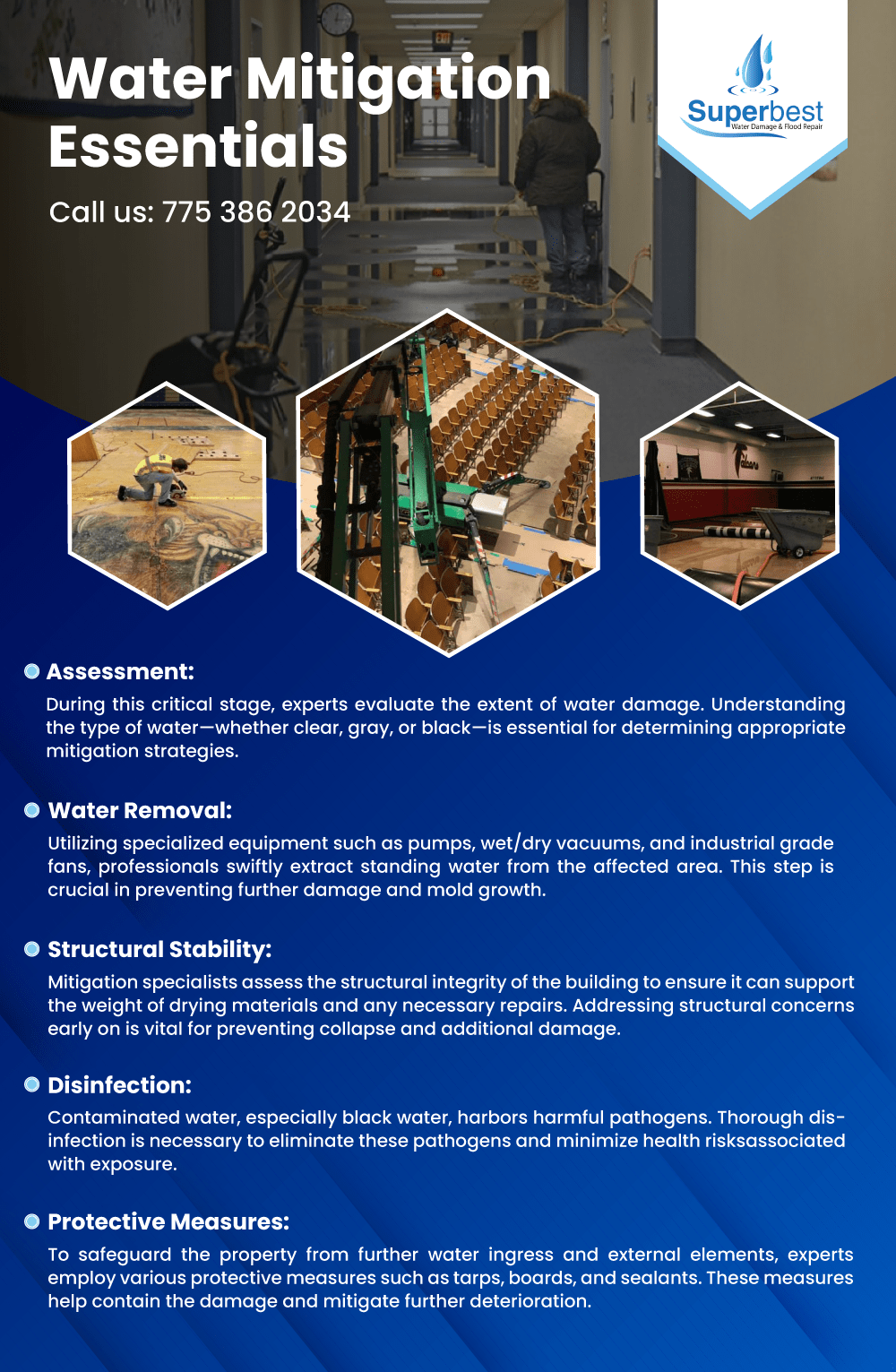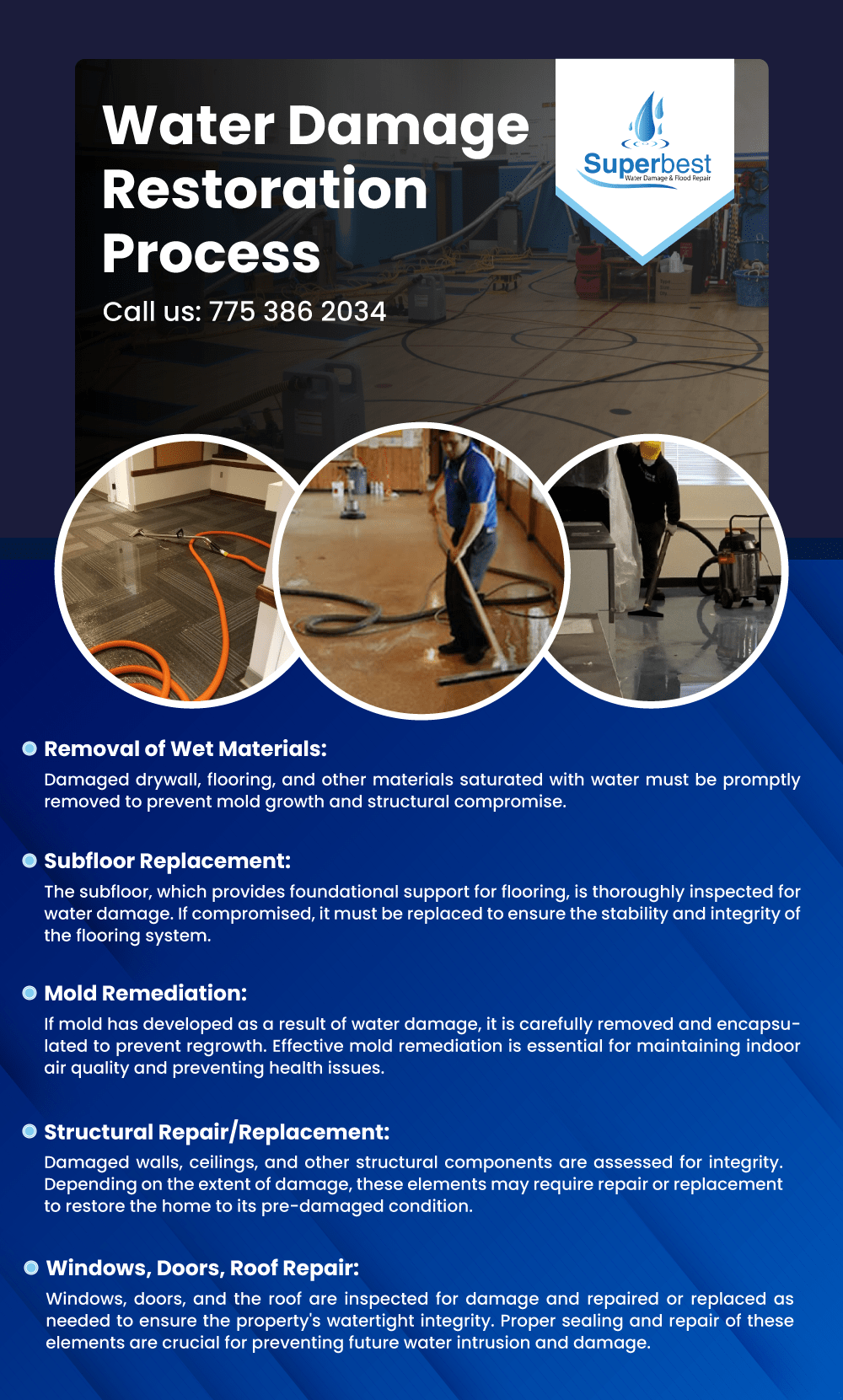Water damage is a common occurrence in homes, often caused by unforeseen events like burst pipes, overflowing appliances, or heavy flooding. While minor leaks can sometimes be handled independently, extensive water damage requires prompt professional intervention. To effectively address water damage, it’s crucial to understand the distinction between water mitigation and water damage restoration.

Water Mitigation: The Initial Response
Water mitigation is the immediate action taken to control and prevent further water damage from spreading. This stage involves stopping the water source, assessing the damage, removing wet materials, and drying out the affected area. Here’s a breakdown of the key steps involved in water mitigation:
Assessment: The mitigation team evaluates the extent of the water damage, determining the type of water (clear, gray, or black) to identify the appropriate approach.
Water Removal: Using pumps, wet/dry vacuums, and industrial-grade fans, the team extracts the standing water and dries out the affected areas to prevent further damage.
Disinfection: Contaminated water, such as black water, requires disinfection to eliminate harmful pathogens and prevent mold growth.
Structural Stability: Mitigation experts assess the structural integrity of the building to ensure it can withstand the weight of drying materials and potential structural repairs.
Protective Measures: Tarps, boards, and sealants are employed to prevent further water ingress and protect the property from external elements.
Water Damage Restoration: Restoring the Home
Water damage restoration is the comprehensive process of repairing and restoring a water-damaged home to its pre-damaged condition. It typically follows water mitigation and involves multiple stages:
Removal of Wet Materials: Damaged drywall, flooring, and other wet materials are removed to prevent mold growth and structural damage.
Subfloor Replacement: The subfloor, the base layer beneath the flooring, is inspected and replaced if damaged by water.
Mold Remediation: If mold has developed due to water damage, it’s carefully removed and encapsulated to prevent regrowth.
Repair or Replacement of Structural Elements: Damaged walls, ceilings, and other structural components are assessed and repaired or replaced as necessary.
Windows, Doors, and Roof Repair: Windows, doors, and the roof, if damaged, are repaired or replaced to ensure watertight integrity.
Moisture Testing: Rigorous moisture testing is conducted to ensure all materials are completely dry before closing up the property.

Cost Considerations
The cost of water mitigation and restoration varies significantly depending on the extent of the damage, the size of the property, and the type of water involved. For instance, black water damage, due to its potential health hazards and more extensive repairs, typically incurs higher costs compared to clear or gray water damage.
When to Seek Professional Help
While minor water damage may be manageable for DIY enthusiasts, extensive water damage necessitates the expertise of professional water mitigation and restoration companies. Here are some indicators that professional assistance is required:
Water Damage Beyond a Small Area: If the water has affected a significant portion of the home, professional help is essential to ensure thorough and effective mitigation and restoration.
Water from Complicated Sources: Water damage caused by multiple sources, such as a combination of leaking pipes, appliances, and flooding, demands expert handling due to the complexity of the situation.
Structural Concerns: If the water damage has affected the structural integrity of the building, professional expertise is crucial to assess and address any structural issues.
Time Sensitivity: Time is of the essence when dealing with water damage. Professional teams can rapidly assess the situation, implement mitigation strategies, and initiate restoration efforts to minimize further damage and associated costs.
SuperBest Reno: Fast, Reliable Water Damage Solutions for Your Home
In conclusion, water damage can be a disruptive and costly experience. By understanding the distinction between water mitigation and water damage restoration, homeowners can make informed decisions about when to seek professional assistance. Early intervention by experienced professionals ensures the preservation of the home’s structure, prevents long-term health hazards, and minimizes financial strain.
In conclusion, addressing water damage in Reno is crucial for maintaining the structural integrity and safety of homes and buildings. Whether caused by natural disasters, plumbing issues, or other unforeseen events, prompt and effective water damage restoration is essential. Residents and property owners in Reno should prioritize proactive measures, such as regular inspections and maintenance, to minimize the risk of water damage. Additionally, seeking professional assistance and employing advanced technologies can play a pivotal role in mitigating the impact of water damage and ensuring a swift and thorough recovery process. By emphasizing preventive measures and timely interventions, the community can better protect their properties and contribute to a resilient and water-damage-resistant environment in Reno.
